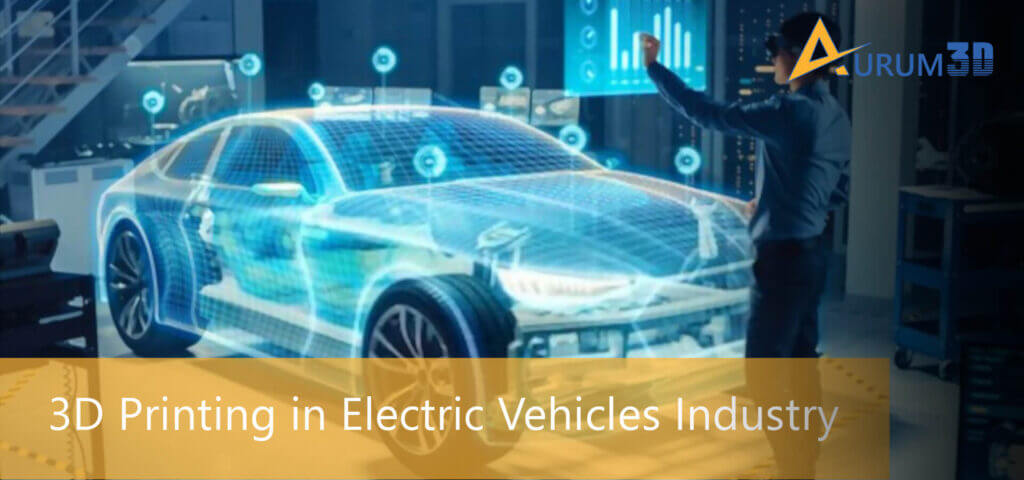The worldwide automotive 3D printing market has been growing steadily. In addition to changing the way conventional vehicles are designed and produced, 3D printing technologies have been driving the development of electric vehicles. Leading electric vehicle manufacturers already form partnerships with 3D printing companies to accelerate the designing, development, and customization of various electric vehicles.
According to a market forecast report published by IndustryARC,
“The exceptional growth prospects of the electric vehicles market is a major growth factor for the 3D printing automotive market owing to its growing importance in electric vehicles. 3D printing is seen as a solution by the OEMs in the global market.”
The applications of 3D printing in the electric vehicles industry vary across automakers. Some automakers these days prefer 3D-printing electric vehicles instead of producing electric vehicles using traditional production methods. At the same time, many automakers 3D print batteries, components, and parts that will drive new-generation electric vehicles.
3D printing technologies are expected to make electric vehicles affordable to millions of consumers in the near future. Electric vehicle manufacturers have been using 3D printing technologies in a variety of ways to curtail both time and costs. We can understand and assess the huge significance of 3D printing in electric vehicles industry based on some interesting applications and use cases.
Interesting Use Cases of 3D Printing in Electric Vehicles Industry
3D Printing Electric Vehicles
Many automakers these days 3D print various parts and components of conventional vehicles to save cost and time. Recently, a startup revealed the first-ever 3D-printed electric vehicle in the UK. The technology startups 3D print a single-seater electric vehicle after several months’ research and experimentation. The startup has already announced its plan to launch many functional and sustainable electric vehicles in the future.
The experimentation will create innovative use cases in the electric vehicles industry by starting trends. Leading automakers will soon launch electric vehicles that are 3D-printed end-to-end. In addition to reducing production time and cost, the use cases will create opportunities for innovation and customization. At present, 3D-printed electric vehicles facilitate only short-distance transport. The next-generation electric vehicles are expected to facilitate long-distance transport.
Facilitating Mass Customization
Most automakers these days support customization and personalization to boost the sale of conventional vehicles. They will use mass customization as a marketing tool to persuade buyers to opt for electric vehicles. They need to ensure that an electric vehicle is designed and customized according to the buyer’s preferences and requirements. Unlike conventional production methods, 3D printing technologies facilitate mass customization of electric vehicles without increasing cost.
Leading automakers already use 3D printers to deliver electric vehicles that are fully customized and aesthetically pleasing. Many engineers leverage 3D printing technologies to make changes to an electric vehicle during both the designing and modeling stages. Also, they support mass customization to optimize a vehicle according to precise conditions and environments. Every customer will soon have the option to buy electric vehicles that appears unique.
Developing Electric Vehicle Battery 3D Printer
Industrial 3D printers are not designed with native features to print electric vehicles. Often engineers have to finetune existing industrial 3D printers while designing and printing electric vehicle batteries. But many technology companies and startups have been launching 3D printers that are customized and optimized to produce electric vehicle batteries. The 3D printers are developed from scratch to facilitate the production of multi-materials and multi-process batteries for electric vehicles.
An engineer can use this specially designed 3D printer to produce high-performing batteries for electric vehicles. Also, the 3D printer helps engineers to develop low-cost electric vehicle batteries by reducing material costs up to 50%. The early models of electric vehicle battery 3D printers are simple. But they can produce batteries using a variety of filaments, including metal and ceramic. The next-generation 3D printers are expected to facilitate the mass production of batteries for electric vehicles.
3D Printing Battery Electrodes
The quality of battery electrodes directly impacts the electric vehicle’s functionality and performance. Many automakers still produce battery electrodes using the conventional slip casting method. But the conventional slip casting method increases the battery’s weight significantly. 3D printing or additive manufacturing technologies enable engineers to produce high-performing and lightweight battery electrodes.
In addition to reducing battery weight up to 50%, 3D printers create both design freedom and geometric freedom. Leading automakers already 3D-print batteries to curtail the overall weight and cost of electric vehicles. Likewise, engineers have been leveraging 3D printing to produce more powerful battery cells by combining cathodes and anodes.
Producing Electric Vehicles Components on Demand
The governments and automakers have been taking new initiatives regularly to persuade buyers to switch to electric vehicles. But many market analysts believe that no surge will be noted in the demand for electric vehicles in the short run. The leading automakers will initially produce and launch electric vehicles in low volume.
The conventional production methods do not support the low-volume production of electric vehicles. The automakers will use advanced industrial 3D printers to launch specific electric vehicle models. Also, they will leverage 3D printing technologies to deliver spare parts and key components of electric vehicles on demand.
Setting up Micro and Local Factories
3D printing technologies enable electric vehicle manufacturers to switch from mass-production to low-volume and customized production. Leading automakers already use 3D printing to eliminate the need to set up large and expensive factories. Many companies will 3D print electric vehicles by setting up factories across geographies. But they will set up micro and local factories strategically across regions.
The companies that 3D print vehicles have already set up micro-factories by replacing conventional production methods completely. Small companies and automakers will soon leverage 3D printers to set up factories that deliver customized electric vehicles to buyers on demand. They will reduce infrastructure costs significantly by leveraging factory automation.
While assessing the significance of 3D printing in the electric vehicles industry, we must remember that the market share of electric vehicles currently stands at around 4%. The automakers will launch new electric vehicles regularly in the short run to create and sustain demand. That is why; many new use cases of 3D printing technologies in the electric vehicles industry will be created over the next few years.
About Aurum3D
Aurum3D is one of the leading 3D printing service providers in India. We have been working with various new age areas like Drone manufacturing and Electric vehicle manufacturers in multiple areas like prototyping and custom 3D printing. You can get in touch with us for your custom requirements in electric vehicle manufacturing.

